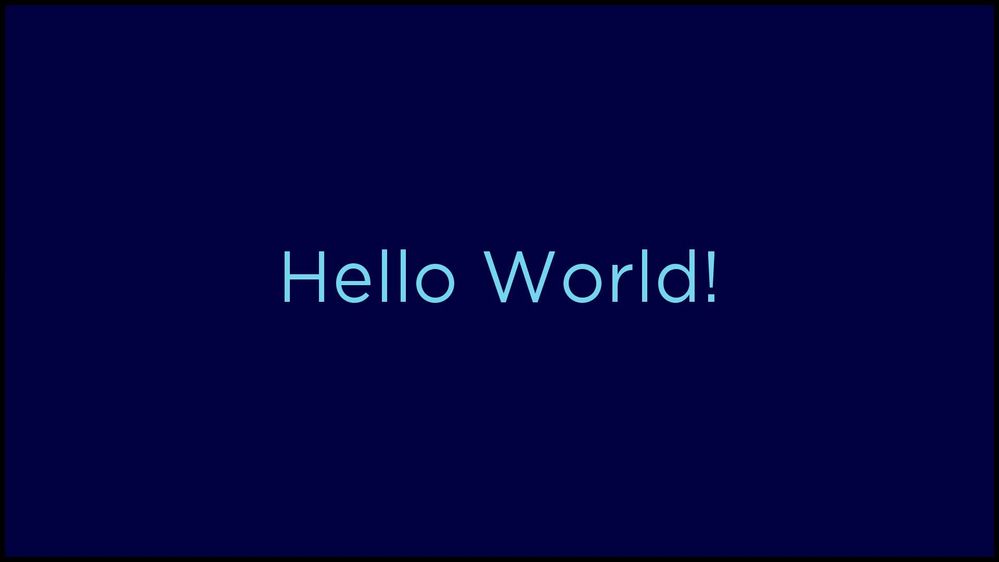Roku Developer Program
- Roku Community
- :
- Developers
- :
- Roku Developer Program
- :
- how can create dynamic gradient?
- Subscribe to RSS Feed
- Mark Topic as New
- Mark Topic as Read
- Float this Topic for Current User
- Bookmark
- Subscribe
- Mute
- Printer Friendly Page
- Mark as New
- Bookmark
- Subscribe
- Mute
- Subscribe to RSS Feed
- Permalink
- Report Inappropriate Content
how can create dynamic gradient?
We want to use dynamic gradient in our roku app. Is there any way to create it?
Please help.
- Mark as New
- Bookmark
- Subscribe
- Mute
- Subscribe to RSS Feed
- Permalink
- Report Inappropriate Content
Re: how can create dynamic gradient?
Not nicely, no. There's no css-style gradient support.
You would need to create a roBitmap, and then write rectangles to represent the gradient.
Then write it to tmp:
Then pass the uri out to the poster node (or wherever needs to read it)
- Mark as New
- Bookmark
- Subscribe
- Mute
- Subscribe to RSS Feed
- Permalink
- Report Inappropriate Content
Re: how can create dynamic gradient?
w = 1920
h = 1080
bm = CreateObject("roBitmap", {width: w, height: h, AlphaEnable: false})
bm.DrawRect(10, 10, w-20, h-20, &H8080)
bm.Finish()
ba = bm.GetPng(0, 0, w, h)
ba.WriteFile("tmp:/test.png")
Use this but it doesn't look like gradient.
- Mark as New
- Bookmark
- Subscribe
- Mute
- Subscribe to RSS Feed
- Permalink
- Report Inappropriate Content
Re: how can create dynamic gradient?
Here's a function you can use to generate vertical and horizontal linear gradients. Keep in mind, this function takes over 1000ms on my streaming stick 4k for a 1920x1080 image, so use it sparingly.
function GenerateGradient(width as integer, height as integer, startRgba as longinteger, endRgba as longinteger, lineDirection = "vertical")
bitmap = CreateObject("roBitmap", { width: width, height: height, alphaEnable: true })
'draw vertical lines from left to right
if lineDirection = "vertical" then
numSteps# = width
'draw horizontal lines from top to bottom
else
numSteps# = height
end if
' separate rgba values to compute the step between each gradient band
red# = (startRgba and &hFF000000&) >> 24
redEnd# = (endRgba and &hFF000000&) >> 24
redStep# = (redEnd# - red#) / numSteps#
blue# = (startRgba and &h00FF0000&) >> 16
blueEnd# = (endRgba and &h00FF0000&) >> 16
blueStep# = (blueEnd# - blue#) / numSteps#
green# = (startRgba and &h0000FF00&) >> 8
greenEnd# = (endRgba and &h0000FF00&) >> 8
greenStep# = (greenEnd# - green#) / numSteps#
alpha# = startRgba and &h000000FF&
alphaEnd# = endRgba and &h000000FF&
alphaStep# = (alphaEnd# - alpha#) / numSteps#
for i = 0 to numSteps#
red# += redStep#
blue# += blueStep#
green# += greenStep#
alpha# += alphaStep#
'merge rgb into single int
color& = (Int(red#) << 24) + (Int(blue#) << 16) + (Int(green#) << 😎 + (Int(alpha#))
if lineDirection = "vertical" then
'draw a line at (i, 0) for the full height of the image
bitmap.DrawRect(i, 0, 1, height, color&)
else
'draw a line at (0, i) for the full width of the image
bitmap.DrawRect(0, i, width, 1, color&)
end if
end for
bitmap.Finish()
png = bitmap.GetPng(0, 0, width, height)
uri = "tmp:/linear-gradient-" + str(width) + "x" + str(height) + "-0x" + stri(startRgba, 16) + "-0x" + stri(endRgba, 16) + "-" + lineDirection + ".png"
png.WriteFile(uri)
return uri
end function
And you can call it like this:
verticalGradientUrl = GenerateGradient(1920, 1080, &h00000000, &hFF0000FF, "vertical")
horizontalGradientUrl = GenerateGradient(1920, 1080, &h00000000, &hFF0000FF, "horizontal")

The function has not been optimized, meaning it will draw a line for every pixel in the gradient, even if several lines would have the exact same color. It could be optimized to draw a rectangle that is as big as the height/width of the color band.
If you're in control of the poster size, then you should consider generating a gradient that's 1 pixel in the opposing direction. (i.e. 1920x1 or 1x1080), then you can stretch the poster to the size you need in that opposing direction.
- Mark as New
- Bookmark
- Subscribe
- Mute
- Subscribe to RSS Feed
- Permalink
- Report Inappropriate Content
Re: how can create dynamic gradient?
- Mark as New
- Bookmark
- Subscribe
- Mute
- Subscribe to RSS Feed
- Permalink
- Report Inappropriate Content
Re: how can create dynamic gradient?
Oh, sorry, I had a bug in my code. I was missing the << 8 for the green channel. I updated my sample snippet, it should work now.
I also just uploaded a full working example of this to the RokuCommunity samples repository, so feel free to pull that down and sideload it to see it working in action.
https://github.com/rokucommunity/sample-projects/tree/master/gradient
- Mark as New
- Bookmark
- Subscribe
- Mute
- Subscribe to RSS Feed
- Permalink
- Report Inappropriate Content
Re: how can create dynamic gradient?
Thank you!! It's working.
- Mark as New
- Bookmark
- Subscribe
- Mute
- Subscribe to RSS Feed
- Permalink
- Report Inappropriate Content
Re: how can create dynamic gradient?
it works fine here!
just to improve, is there any way to create the gradient by passing angle degrees?
- Mark as New
- Bookmark
- Subscribe
- Mute
- Subscribe to RSS Feed
- Permalink
- Report Inappropriate Content
Re: how can create dynamic gradient?
I'm sure there is, but that gets a lot harder! The current method just walks left-to-right or top-to-bottom and writes pixels. By using an angle, you'd need to calculate the positions of each pixel along the angle plane and then walk all the boxes that way....probably dealing with when the pixels fall off the visible dimensions.
If you get ambitious enough to implement that, feel free to open a PR in this sample project and I'll update my code snippet: https://github.com/rokucommunity/sample-projects/tree/master/gradient
- Mark as New
- Bookmark
- Subscribe
- Mute
- Subscribe to RSS Feed
- Permalink
- Report Inappropriate Content
Re: how can create dynamic gradient?
When I tried to use these following color it does not work. Is there any limitation to use it? please suggest?
&H00000000, &H00800000, &H00008000, &H00808000, &H00808080, &H00FF0000, &H0000FF00, &H00FFFF00, &H00FF00FF
Become a Roku Streaming Expert!
Share your expertise, help fellow streamers, and unlock exclusive rewards as part of the Roku Community. Learn more.

